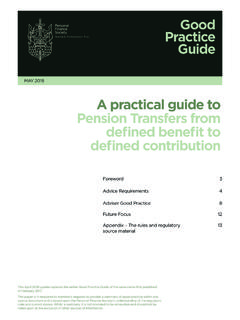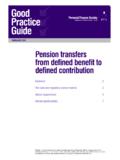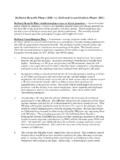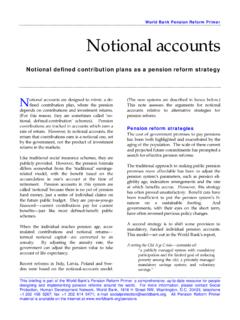Transcription of E A msson Peo 22 2 Employee Explanation No. 2 Benefit
1 CYCLE A Submission Period 02/01/2016 01/31/2017 EmployeeBenefitPlansExplanation No. 2 Minimum Vesting StandardsDefined Contribution PlanNote: Plans submitted during the Cycle A submission period must satisfy the applicable changes in plan qualification requirements listed in Section IV of Notice 2015-84, 2014-52 1 (the 2015 Cumulative List). This publication contains copies of:Form 5623, Worksheet 2 Form 6041, Deficiency Checksheet 2 These forms are included as examples only and should not be completed and returned to the Internal Revenue 6389 (Rev. 4-2016) Catalog Number 48145A Department of the Treasury Internal Revenue Service technical principles in this publication may be changed by future regulations or purpose of the Worksheet Number 2 (Form 5623) and this Explanation is to identify major problems in the area of plan vesting. However, there may be issues not mentioned in the worksheet that could affect the plan s worksheet applies only to plans to which Internal Rev-enue Code section 411 applies, except plans mentioned in section 411(e) (such as governmental plans) and plans that cover participants who are employed in maritime or seasonal , a Yes answer to a question on the worksheet in-dicates a favorable conclusion while a No answer signals a problem concerning plan qualification.
2 This rule may be altered by specific instructions for a given question. Please explain any No answer in the space provided on the sections cited at the end of each paragraph of explana-tion are to the Internal Revenue Code, the Income Tax Regu-lations, and the Department of Labor (DOL) Regulations. Rev. Rul. means Revenue Ruling. A basic requirement to keep in mind for the vesting standards is that each participant s vest-ed interest must satisfy the statutory minimum at all times. A plan that generally provides faster vesting than the statutoryminimum will not fail to qualify merely because the plan does not adhere to the specific language found in the statute. For example, a plan that provides full and immediate vesting at age 21 would satisfy the statutory minimum vesting require-ments even though language about a requirement for years of service is not found in the A Submission Period 02/01/2015 01/31/2017 Page 2I. Years of Service And Breaks in ServiceThis section applies only to plans in which years of service are a factor in determining a participant s vested interest.
3 Therefore, DO NOT complete this section if the plan provides full and immediate vesting for each participant. Questions a. through f. and l. through p. apply to plans that count hours of service. Questions g. through p. apply to plans that use the elapsed time method of counting service. Line a. A vesting computation period is a 12-consecutivemonth period used to determine whether an Employee has completed a year of service for vesting purposes. Any plan must designate a vesting computation period, except a plan that uses an elapsed time method of counting service, or a plan in which years of service are not a factor in determining a participant s vested interest. DOL Regs. (a)DOL Regs. b. Depending on the definition of hour of service and the method used to count these hours, a plan must credit an Employee with 1 year of service for vesting if the Employee completes at least 1000, 870, or 750 hours of service in a vesting computation period. (i) (H = 1000) A plan that counts all hours of service, or that uses an equivalency based on a period of employment (day, week, semi-monthly payroll period, month, or shift), cannot require the completion of more than 1000 hours of service.
4 411(a)(5)(a)DOL Regs. (a)DOL Regs. (e)(ii) (H = 870) A plan that counts hours worked, or that uses an equivalency based on earnings for an Employee who is compensated on an hourly rate, cannot require the completion of more than 870 hours of Regs. (d)(1)DOL Regs. (f)(1)(iii) (H = 750) A plan that counts regular time hours, or that uses an equivalency based on earnings for an Employee who is compen-sated on a basis other than an hourly rate, cannot require the completion of more than 750 hours Regs. (d)(2)DOL Regs. (f)(2)Answer the following by using the applicable method of counting hours (i, ii, or iii above).Line c. If a plan counts all hours of service, credit each hour for which (1) an Employee is paid or entitled to payment for the performance of duties, (2) an Employee is paid or entitled to payment because of a period of time during which no duties are performed, and (3) back pay is either awarded or agreed to by the employer. Note: Item (2) may be limited to 501 hours for any single occurrence.
5 DOL Regs. (a)If a plan credits hours of service by an equivalency based on a period of service, and an Employee is required to be credited with at least 1 hour of service under the paragraph above, then, depending on the basis used, the plan must credit hours of service as follows: Basis of Equivalency Number of Hours least least 45Bi-weekly payroll least least 190 DOL Regs. (e)If a plan counts hours worked, credit each hour for which an Employee is paid or entitled to payment for the performance of duties; also credit hours for which back pay is awarded, or agreed to, by the employer to the extent that the back pay covers a period in which the Employee would have been employed in the performance of duties for the employer. DOL Regs. 2530. 200b-3(d)(3)(i) If a plan counts regular time hours, credit each hour for which an Employee is paid or entitled to payment for the performance of duties (except hours for which a premium rate is paid).
6 DOL Regs. (d)(3)(ii)If a plan credits hours of service by an equivalency based on earnings for an Employee who is compensated on an hourly rate, an Employee must be credited during a computation period with at least the number of hours equal to either the Employee s total earnings-- (1) from time to time during the computation period, divided by the hourly rate of those times; or (2) for performance of duties during the computation period divided either by the Employee s lowest hourly rate during that time, or by CYCLE A Submission Period 02/01/2015 01/31/2017 Page 3the lowest hourly rate payable to an Employee in the same, or a similar, job classification. DOL Regs. (f)(1)(i)If a plan credits hours of service by an equivalency based on earnings, and determines compensation other than on an hourly rate, the Employee must be credited during a computation period with at least the number of hours equal to his or her total earnings for du-ties performed during that period, divided by the Employee s lowest hourly rate of compensation during the same period.
7 (See the DOL Regulations.) Note: If the same hourly rate of compensation is used for all employees, this method may result in discrimination in favor of highly compensated employees. DOL Regs. (f)(2)Line d. If H = 1000 in b., above, answer this question; otherwise check N/A. If a plan credits hours of service for periods during which no duties are performed, the plan must designate the method of determining the number of hours to be credited and the method of crediting the hours to the computation periods. The plan must conform to the requirements of DOL Regulations sections (b) and (c). Section (f) of the DOL Regulations, however, also indicates that a plan is not required to state these rules if they are incorporated by Regs. 2530-200b-2(b), (c) & (f)Line e. The break in service rules allow a plan to disregard certain service before the Employee has a break. If all of an Employee s service with an employer is counted for vesting, the plan need not provide these rules.
8 In this case check N/A. Depending on the definition of hour of service and the method used to count these hours, a plan may charge an Employee with a break in service for any vesting computation period in which the Employee fails to complete more than B hours of service. The number re-quired for B, if a certain method of counting hours is used, equals half of the hours used in question b. of this section of the worksheet. Therefore, a plan may provide that an Employee be charged with a break in service if in a computation period the Employee fails to complete: more than 500 hours of service in a plan that counts all hours of service; or, more than 435 hours if the basis used is hours worked ; or, more than 375 hours if the basis is regular time hours. DOL Regs. & 4 DOL Regs. (d)Line f. An individual shall be credited with certain hours of service if such individual is absent from work for any period by reason of 1) pregnancy of the individual, 2) birth of a child of the individual, 3) placement of a child with the individual in connection with an adop-tion or 4) caring for a child described in (2) or (3) immediately following such birth or placement.
9 This credit is credit for maternity or paternity leave. Credit for maternity or paternity leave is only made to avoid a break in service and not to obtain a year of service. The absence does not have to be approved leave. Credit for maternity or paternity leave is required only if such leave is on account of the reasons described above. Thus if an individual quits employment with employer A and two years later adopts a child, no credit under this provision would be given if the individual even-tually returns to work for employer A because said individual s absence from employer A s workplace is on account of quitting and not on account of the adoption of or the caring for the child immediately following the adoption. Hours of service must be credited to the computation period in which the first hour of maternity or paternity leave occurs, if such individ-ual would experience a break in service with respect to such computation period if such maternity or paternity leave is not credited and such individual will not experience a break in service if such maternity or paternity leave is credited.
10 If such maternity or paternity leave is not credited to the first computation period, it is credited to the second computation period whether or not it is needed to preclude a break in rules may be illustrated with the following example: Individual A separates from service on March 1, 2006, of a calendar year com-putation period after earning 300 hours of service. The plan defines a year of service as a computation period in which the Employee earns 1000 hours. The employer provides for paid maternity leave for a period not to exceed 300 hours. Under the normal rules of crediting service paid maternity leave must be credited for service. Therefore, individual A in 2006 would not experience a break in service even if the hours required to be credited are not so credited. Accordingly, no hours of service would be credited to the first computation period in 2006. Therefore, all such hours of service are credited in the second computation period of 2007. The number of hours credited with respect to a computation period is the number of hours such individual would normally have worked in the computation period if such individual were not on maternity or paternity leave.
















